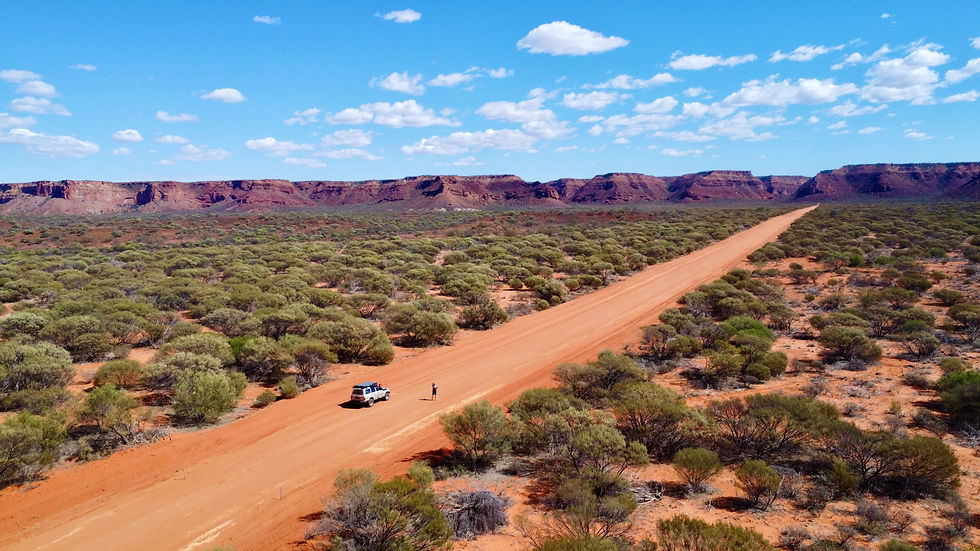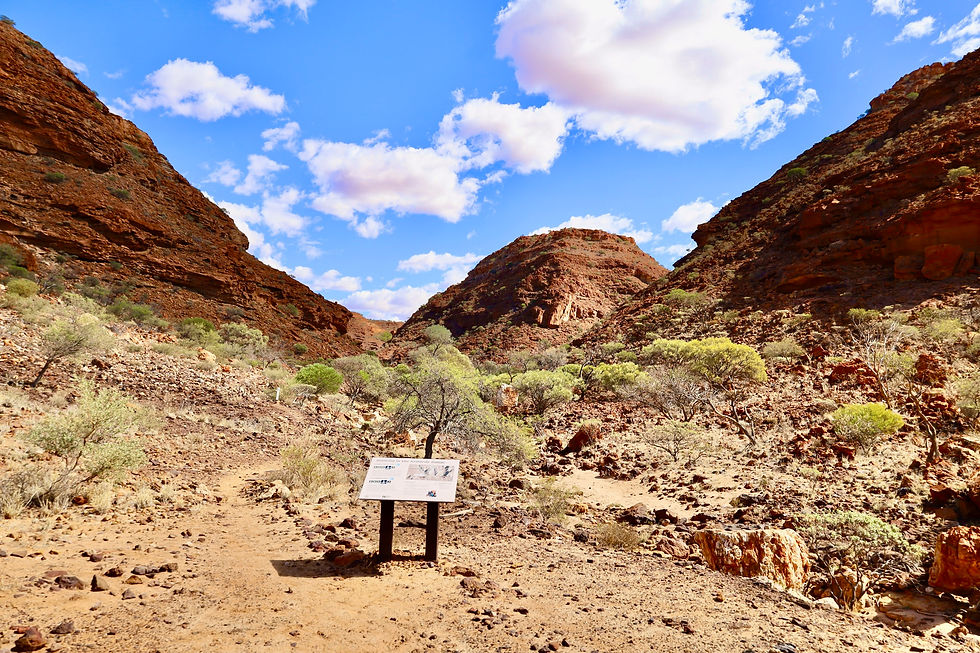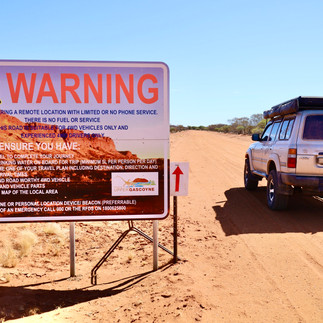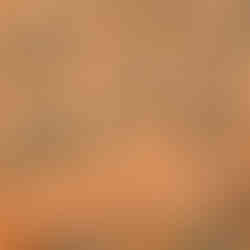BIG THINGS ... Exploring Midwest WA through Gascoyne and on the Kennedy Ranges
- Woolgoolgaoffroad
- Jul 18, 2023
- 5 min read
Updated: Mar 29
We’re pretty lucky in Australia with so many ‘big things’ whether man-made or natural, so while on tour in WA I thought I’d check out one of the biggest natural wonders in the world, Mount Augustus.

After fueling up, restocking and a quick car service at Carnarvon on WA’s midwest coast I headed east along the Carnarvon highway towards Gascoyne Junction. With a good 450km drive to the world's biggest rock, I settled in for the long haul on what seemed like an endless sealed road running beside the Gascoyne River.

With a break at Gascoyne, I read about the Kennedy Ranges, just 60 km to the north where you can view stunning rock gorges and hike into natural waterholes. On the way to the Kennedy Range turn off there’s remnants of an old Cobbled road that early pioneers and drovers used.

The wool wagon pathway was built around 1920 with local stone for wagons on tracks that were little more than rough clearings through the scrub. When it rained, all but high or stony areas turned to mud, and when it was dry the sandy ridges were almost impossible to cross.

KENNEDY RANGES
It’s good dirt into the park and straight away the eastern escarpment seems to loom at you as you head directly towards it, with its massive jaggered outcrops and tall columns. Impressive is definitely an understatement for the 250 million-year-old weathered rocks that glow in the sun from every angle you view them.

Camping is allowed at Temple Gorge which is a good place to base yourself for the hikes into the ranges, whether it be the stunning sunrise view, Honeycomb, Drapers, Temple or the bigger Escarpment hikes.

Apparently, this area was a shallow ocean basin over 200 million years ago and with the complicated movements of the earth and ocean receding, marine fossils can still be found in the sandstone throughout this huge mesa that’s about 75km long and 25km wide.
KENNEDY RANGE LOOP TRACK
Something else that caught my eye was the Kennedy loop track that covers the top of the range and is only suitable for high clearance 4wds. Starting at the northern end of the park, the loop track heads into pastoral stations that have been bought to make up the 320,000-hectare park over the years.
From the start, the track covers a variety of terrain from rows of red dunes, and narrow sections following steep cliffs with endless views to the east, and a maze of steep-sided canyons to drive through over sharp-cut rocks and along washed out creek beds.

All the way along the track the scenery is nothing short of spectacular with its ancient rock formations, huge slabbed rock and massive gums. On the western boundary of the range, a number of natural springs give life to little pockets of the park.

Free camping is allowed up here but not too close to the water, as the animals still have to use the only water source, all this from a substantial geological fault millions of years ago.

More than 400 plant species, over 100 different birds, and 20 mammal species have been recorded across this unique plateau. My loop trail ended at the mighty Gascoyne River and during the wet, this river is totally impassable. I crossed it when it was relatively dry but it was still wheel depth, and then another 200 m of dry river sand to cross out of the Gascoyne.

It would have taken decades of wet seasons and cyclone rain to carve the river to what it is now, even tho it's nearly 200km to the coast. Just out of the Gascoyne River, new campgrounds have opened up at Winnemia station.
An old workers' cottage has been converted for campers with toilets, but it's still a remote camp and you’ll need to be pretty well set up, as Gascoyne is still two hours away. The Loop track was about 100km long but with so much to see and do it took a good day to explore.
The remote and isolated Kennedy loop track should only be attempted by high clearance 4wds and those who are confident with remote tracks.
Mount Augustus
Now my priority was to head to Mount Augustus so by heading back into Gascoyne Junction and heading along the Mullewa dirt road and up along the Cobra Creek road towards the rock for another 300km.

Now most people think that Uluru is a large rock and a huge monolith it is, but Mount Augustus is next level where it's visible from 60km away and 2.5 times larger than Uluru and estimated to be over 1800 million years old.

Just like the Kennedy Ranges a complex process began when the inland sea dried up, the earth moved and a weathering process started. Marine layers are still visible in the area away from the rock. The only place to stay is on Mount Augustus station where you’ll have stunning views of the rock from camp especially at sunrise.

One of the best things you can do here is the 45km drive around the base of Mount Augustus to view this huge monster from different angles and explore the variety of hikes into and up the mountain.

The hikes are grade 3 and 5 depending on their length and distance. The more serious hikes can attempt the summit walk but it's an extreme and difficult hike, other smaller walks go into significant areas that are only 200 m long. The Wajarri people call this area home and would roam across the Gascoyne region and in times of drought they knew there were natural springs at the base of the mountain.

Some of the smaller walks take you to where the Wajarri people left engravings on the rocks. These petroglyphs highlight their existence with an amazing array of animal, human and dream time engravings. I found there were plenty of areas to sit and ponder just what the symbols meant, who carved them and why here. Other walks took me into cattle soaks, across dry waterways points with amazing views across what seems like desolate plains.

Mount Augustus is an ‘inselberg’ which means an island mountain, just like a mountain rising from the sea, it’s 715 metres high in the arid landscape of mid-eastern WA, with a mixture of wattles, spinifex and cassias covering its surrounds.

Now while this underrated rock is overshadowed by the other rock, it's an amazing journey to visit and learn of its history along with nearby Kennedy ranges. Definitely, one trip I highly recommend.
WHERE
The Kennedy Ranges entry is just under 200km east of Carnarvon on a good sealed road and the Kennedy Loop track is unsealed and very much unmaintained so driving it is at your own risk. Mount Augustus is a further 260km past Gascoyne on good unsealed roads which may get closed in wet weather. Or drive from Meekatharra which is 350km away.

WHAT TO SEE AND DO
Explore the Kennedy Ranges either on foot or by 4wd. On the eastern side and the base of the ranges, there are walks into stunning gorges, hikes up to see an early morning sunrise or longer and harder hikes for the more adventurous. For the 4wd nut, there’s the Kennedy Loop track that tackles the top of the range, with impressive views, history to explore and a more than interesting drive over different terrains.

Experience is needed for this remote and isolated drive. Then there’s plenty of flora and fauna for the naturalists. Mount Augustus is the world's largest rock with plenty of hiking trails and an easy 4wd loop track at its base. Camping is available at Temple Gorge in the Kennedy Ranges and at Mt Augustus Tourist Park. Don’t attempt exploring this area during summer, as the daytime temperatures can cause a variety of health issues including death. Drink plenty of water and be safe.
MORE INFO
Most info for this area can either be found online, through WA Parks and wildlife service, in Gascoyne Junction or by contacting the Carnarvon info centre regarding the Kennedy Range or Mount Augustus Tourist Park ( 08 99430527 ).



















































Some excellent information about Kennedy Ranges Loop track!